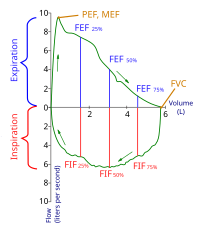
Photo from wikipedia
BackgroundFew studies have examined the relationships between sputum inflammatory markers and subsequent annual decline in forced expiratory volume in 1 s (dFEV1). This study investigated whether indices of airway inflammation are… Click to show full abstract
BackgroundFew studies have examined the relationships between sputum inflammatory markers and subsequent annual decline in forced expiratory volume in 1 s (dFEV1). This study investigated whether indices of airway inflammation are predictors of dFEV1 in a general population-based sample.MethodsThe study, conducted from 2003 to 2005, included 120 healthy Norwegian subjects aged 40 to 70 years old. At baseline, the participants completed a self-administered respiratory questionnaire and underwent a clinical examination that included spirometry, venous blood sampling, and induced sputum examination. From 2015 to 2016, 62 (52%) participants agreed to a follow-up examination that did not include induced sputum examination. Those with a FEV1/forced vital capacity (FVC) ratio < 0.70 underwent a bronchial reversibility test. The levels of cytokines, pro-inflammatory M1 macrophage phenotypes were measured in induced sputum using bead-based multiplex analysis. The associations between cytokine levels and dFEV1 were then analysed.ResultsThe mean dFEV1 was 32.9 ml/year (standard deviation 26.3). We found no associations between dFEV1 and the baseline indices of sputum inflammation. Seven participants had irreversible airflow limitation at follow-up. They had lower FEV1 and gas diffusion at baseline compared with the remaining subjects. Moreover, two of these individuals had a positive reversibility test and sputum eosinophilia at baseline.ConclusionsIn this cohort of presumably healthy subjects, we found no associations between sputum inflammatory cells or mediators and dFEV1 during 10 years of follow-up.
Journal Title: BMC Pulmonary Medicine
Year Published: 2019
Link to full text (if available)
Share on Social Media: Sign Up to like & get
recommendations!